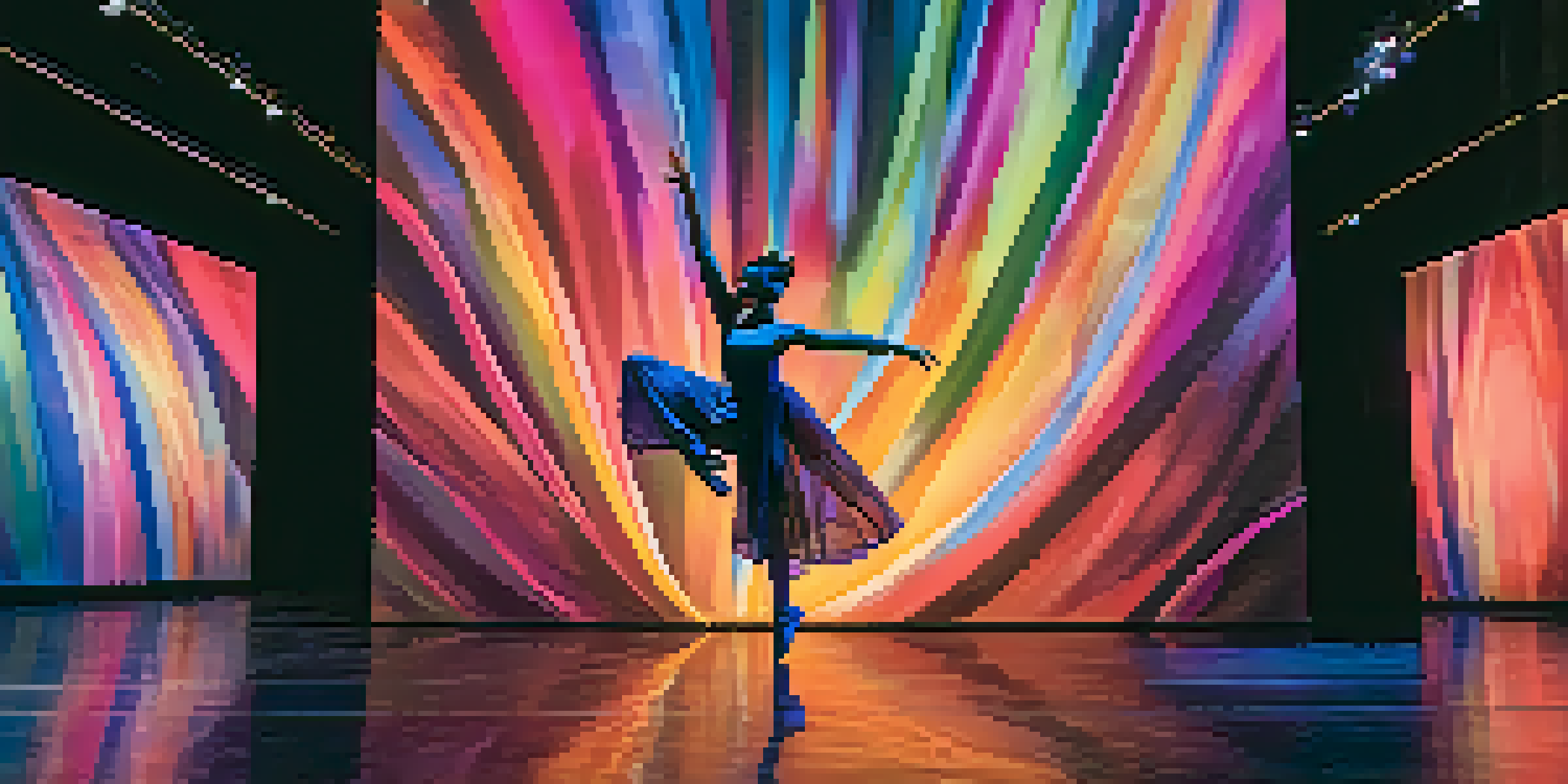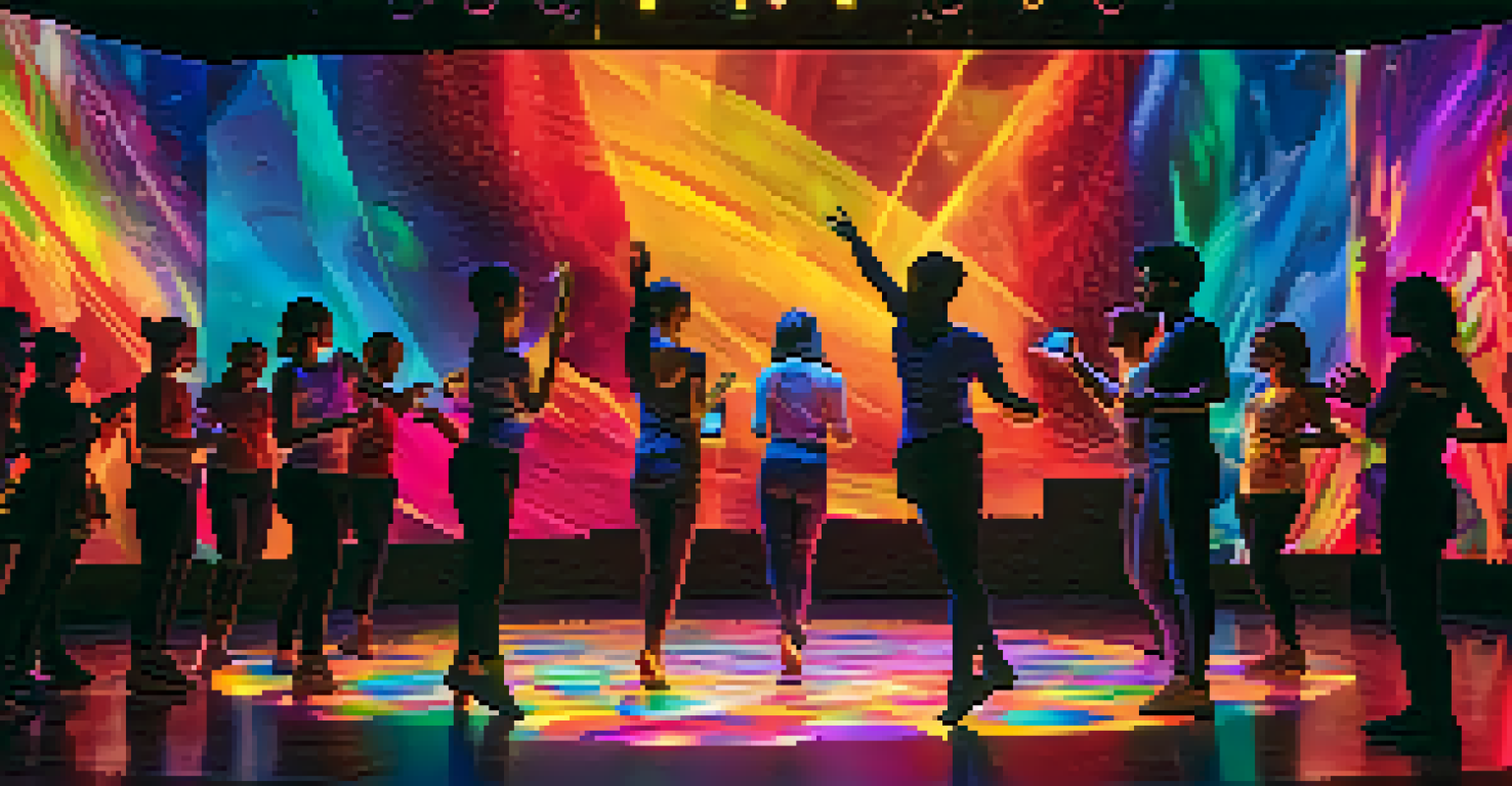Digital Scenography: Merging Dance with Multimedia Elements

Understanding Digital Scenography in Dance
Digital scenography is an innovative approach that combines dance with multimedia elements, creating a new realm of artistic expression. It integrates technology, such as projections, lighting, and sound, to enhance the storytelling of a dance performance. This fusion allows choreographers and dancers to explore themes in ways that were previously unimaginable, pushing the boundaries of traditional performance art.
Dance is the hidden language of the soul.
Imagine a dancer performing on stage, surrounded by vibrant, shifting visuals that respond to their movements. This synergy between the physical and digital worlds creates a dynamic experience for the audience, drawing them deeper into the narrative. As technology continues to evolve, so does the potential for more immersive and interactive performances that captivate viewers.
Digital scenography not only enhances the aesthetic of a performance but also opens up new possibilities for collaboration among artists. Dancers, visual artists, and technologists can work together, merging their expertise to create compelling performances. This collaborative spirit is essential in pushing the envelope of what's possible in the world of dance and multimedia.
The Role of Technology in Modern Dance
Technology has become an integral part of modern dance, influencing choreography and presentation. The use of digital tools allows for the creation of intricate visual effects that can transform a simple dance into a multi-sensory experience. This evolution encourages dancers to think creatively, as they incorporate technology into their movements and performances.

For instance, augmented reality (AR) can bring an entirely new dimension to a performance, enabling dancers to interact with virtual elements in real time. This technology not only enhances the visual storytelling but also invites the audience to engage with the performance on a deeper level. When technology and dance merge, the resulting experience is both innovative and exhilarating.
Digital Scenography Enhances Dance
The integration of multimedia elements in dance performances creates immersive experiences that deepen audience engagement.
Moreover, the accessibility of digital tools has democratized the dance scene, allowing more artists to experiment with multimedia elements. This shift has led to a diverse range of performances that challenge conventional norms and inspire fresh interpretations of dance. As more artists embrace technology, the landscape of dance continues to evolve and thrive.
Exploring the Impact on Audience Engagement
One of the most significant benefits of digital scenography is its ability to enhance audience engagement. When multimedia elements are seamlessly integrated into dance performances, viewers often find themselves more emotionally invested in the story being told. This heightened engagement can lead to a richer, more impactful experience that resonates long after the performance ends.
Technology is best when it brings people together.
For example, a performance that incorporates interactive projections may allow the audience to influence the visuals, creating a unique experience for each show. This level of interactivity breaks down the traditional barrier between performer and spectator, fostering a deeper connection. Audiences are no longer passive observers; they become active participants in the narrative.
Furthermore, the use of social media and live-streaming technology allows performances to reach a broader audience. Dancers can share their work with people who might not have been able to attend in person, creating a global community of dance enthusiasts. This expanded reach not only amplifies the impact of the performances but also encourages dialogue around the art form.
Case Studies: Successful Digital Scenography in Dance
Several notable performances have successfully integrated digital scenography, showcasing the potential of this artistic approach. Take, for instance, the acclaimed dance piece 'Tree of Codes,' which combined choreography with stunning visual projections. The dynamic interplay between the dancers and the projected imagery created a mesmerizing experience that left audiences in awe.
Another example is the work of multimedia artist and choreographer Wayne McGregor, whose innovative performances often feature advanced technology. His piece 'Atomos' utilized digital projections to reflect the dancers' movements, resulting in a captivating visual narrative. These examples illustrate how digital scenography can elevate the art of dance, making it more accessible and engaging for audiences.
Technology Fuels Creative Collaboration
Digital tools allow dancers and artists to collaborate innovatively, merging diverse skills to push the boundaries of performance art.
These successful case studies not only highlight the artistry involved but also inspire other choreographers to explore the possibilities of multimedia integration. As more artists take the plunge into digital scenography, the dance landscape will continue to evolve, offering fresh perspectives and creative explorations.
Challenges of Integrating Multimedia in Dance
While the fusion of dance and multimedia offers exciting possibilities, it is not without its challenges. One major hurdle is the technical aspect of integrating various digital elements into a live performance. Ensuring that everything runs smoothly requires meticulous planning and collaboration among artists and technicians.
Additionally, there can be a learning curve for dancers who are accustomed to traditional forms of performance. Adapting to the presence of technology on stage may require new skill sets and an openness to experimentation. This shift can be daunting, but it also presents a unique opportunity for growth and innovation within the art form.
Moreover, the reliance on technology can sometimes overshadow the core essence of dance. It's crucial for artists to strike a balance between the visual spectacle and the emotional connection that dance inherently possesses. Navigating these challenges is part of the journey in creating compelling and meaningful performances that resonate with audiences.
The Future of Dance and Digital Scenography
As technology continues to advance, the future of digital scenography in dance looks exceptionally bright. Innovations in virtual reality (VR) and artificial intelligence (AI) could transform the way performances are created and experienced. Imagine a performance where the audience can view the dance from multiple perspectives or even influence the choreography through interactive elements.
Moreover, the increasing accessibility of technology encourages more artists to experiment with digital scenography. This democratization of tools is likely to lead to an explosion of creativity, with diverse voices contributing to the evolution of dance. The next generation of choreographers will likely embrace technology as a fundamental part of their artistic practice.
Future of Dance is Tech-Driven
Advancements in technology, such as VR and AI, promise to transform how dance is created and experienced, leading to a new era of artistic expression.
In this rapidly changing landscape, one thing remains clear: the integration of dance and multimedia is here to stay. As artists continue to push the boundaries of creativity, audiences can look forward to captivating performances that challenge perceptions and redefine the art of dance.
Conclusion: Embracing the Digital Dance Revolution
In conclusion, digital scenography represents a groundbreaking shift in the world of dance, merging traditional art forms with cutting-edge technology. This fusion not only enhances the visual and emotional impact of performances but also fosters collaboration among artists. As we embrace this digital dance revolution, it's essential to remain open to new ideas and creative explorations.
The transformative power of digital scenography has the potential to inspire a new generation of dancers and choreographers. By integrating multimedia elements, artists can tell richer stories and engage audiences in ways that transcend traditional performance boundaries. This evolution encourages innovation and sets the stage for the future of dance.

As we look ahead, the possibilities are endless. The marriage of dance and technology will continue to shape the artistic landscape, creating mesmerizing experiences that captivate and inspire audiences around the world. The digital scenography movement is not just a trend; it's a powerful force that is redefining the future of dance.